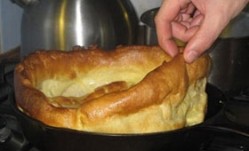Scientists create perfect Yorkshire pudding

Scientists at the Royal Society of Chemistry have devised a recipe for the perfect Yorkshire pudding, which must rise by at least four inches.
The investigation into the perfect recipe was launched by the RSC after Ian Lyness called enquiring about the flatness of his Yorkshires in high altitudes. He was searching for an answer as to why his roast dinner favourite was perfect when tried in England, yet lacklustre when attempted in Boulder, Colorado.
Along with Yorkshireman Dr John Emsley, the RSC established that the perfect Yorkshire pudding must stand at just over four inches, with a light fluffy interior and crisp exterior, and of course be made by a northerner.
Recipe for the perfect Yorkshire pudding:
Ingredients
85 g polysaccharide powder, kitchen grade (flour)
1 g sodium chloride, NaCl, table grade (salt)
1 egg
Solution of 230 cm3 reduced-lipid bovine lactate (milk), 20 cm3 H2O (water)
Method
• Put flour in a bowl, make a well in the middle, add the egg, stir until the two are combined then start gradually adding the milk and water combining as you go.
• Add the liquid until the batter is a smooth and thin consistency.
• Stir in half teaspoon of salt and leave to stand for 10 minutes
• Put beef dripping into Yorkshire pudding tins or into one large tin but don’t use too much fat.
• Put into hot oven until the fat starts to smoke.
• Give the batter a final stir and pour into the tin or tins.
• Place in hot oven until well risen - should take 10 to 15 minutes.
Serve
Always serve as a separate course before the main meal and use the best gravy made from the juices of the roast joint. Yorkshire housewives served Yorkshire pudding before the meal so that they would eat less of the more expensive main course.
NB: When the batter is made it must not be placed in the fridge but be kept at room temperature.
















